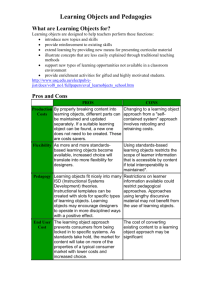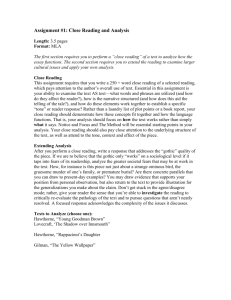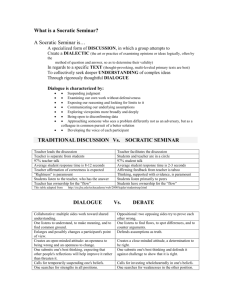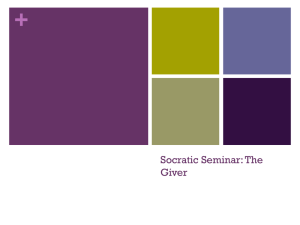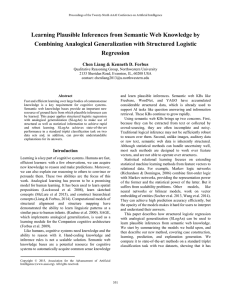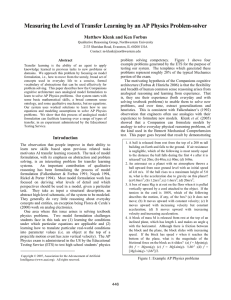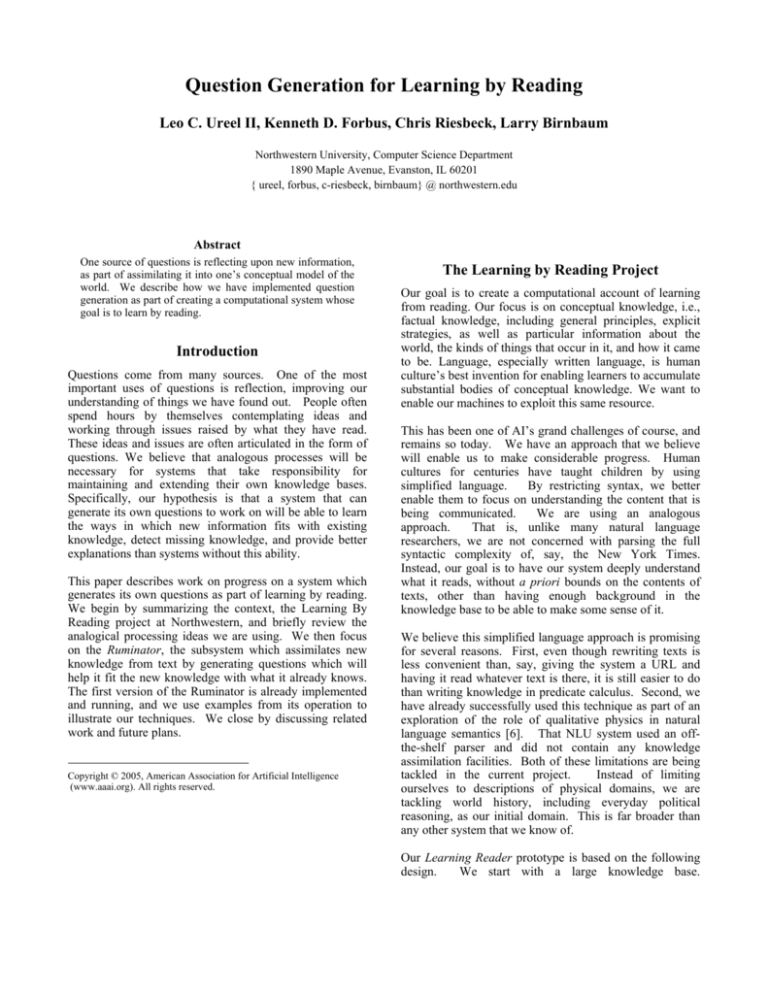
Question Generation for Learning by Reading
Leo C. Ureel II, Kenneth D. Forbus, Chris Riesbeck, Larry Birnbaum
Northwestern University, Computer Science Department
1890 Maple Avenue, Evanston, IL 60201
{ ureel, forbus, c-riesbeck, birnbaum} @ northwestern.edu
Abstract
One source of questions is reflecting upon new information,
as part of assimilating it into one’s conceptual model of the
world. We describe how we have implemented question
generation as part of creating a computational system whose
goal is to learn by reading.
Introduction
Questions come from many sources. One of the most
important uses of questions is reflection, improving our
understanding of things we have found out. People often
spend hours by themselves contemplating ideas and
working through issues raised by what they have read.
These ideas and issues are often articulated in the form of
questions. We believe that analogous processes will be
necessary for systems that take responsibility for
maintaining and extending their own knowledge bases.
Specifically, our hypothesis is that a system that can
generate its own questions to work on will be able to learn
the ways in which new information fits with existing
knowledge, detect missing knowledge, and provide better
explanations than systems without this ability.
This paper describes work on progress on a system which
generates its own questions as part of learning by reading.
We begin by summarizing the context, the Learning By
Reading project at Northwestern, and briefly review the
analogical processing ideas we are using. We then focus
on the Ruminator, the subsystem which assimilates new
knowledge from text by generating questions which will
help it fit the new knowledge with what it already knows.
The first version of the Ruminator is already implemented
and running, and we use examples from its operation to
illustrate our techniques. We close by discussing related
work and future plans.
Copyright © 2005, American Association for Artificial Intelligence
(www.aaai.org). All rights reserved.
The Learning by Reading Project
Our goal is to create a computational account of learning
from reading. Our focus is on conceptual knowledge, i.e.,
factual knowledge, including general principles, explicit
strategies, as well as particular information about the
world, the kinds of things that occur in it, and how it came
to be. Language, especially written language, is human
culture’s best invention for enabling learners to accumulate
substantial bodies of conceptual knowledge. We want to
enable our machines to exploit this same resource.
This has been one of AI’s grand challenges of course, and
remains so today. We have an approach that we believe
will enable us to make considerable progress. Human
cultures for centuries have taught children by using
simplified language.
By restricting syntax, we better
enable them to focus on understanding the content that is
being communicated.
We are using an analogous
approach.
That is, unlike many natural language
researchers, we are not concerned with parsing the full
syntactic complexity of, say, the New York Times.
Instead, our goal is to have our system deeply understand
what it reads, without a priori bounds on the contents of
texts, other than having enough background in the
knowledge base to be able to make some sense of it.
We believe this simplified language approach is promising
for several reasons. First, even though rewriting texts is
less convenient than, say, giving the system a URL and
having it read whatever text is there, it is still easier to do
than writing knowledge in predicate calculus. Second, we
have already successfully used this technique as part of an
exploration of the role of qualitative physics in natural
language semantics [6]. That NLU system used an offthe-shelf parser and did not contain any knowledge
assimilation facilities. Both of these limitations are being
tackled in the current project.
Instead of limiting
ourselves to descriptions of physical domains, we are
tackling world history, including everyday political
reasoning, as our initial domain. This is far broader than
any other system that we know of.
Our Learning Reader prototype is based on the following
design.
We start with a large knowledge base.
Specifically, we are using the contents of Cycorp’s
ResearchCyc knowledge base, plus our own extensions for
qualitative reasoning and analogical processing. This
gives us over 34,000 concepts and over 12,000 predicates
to build upon, covering a wide range of basic knowledge.
(We use our own FIRE reasoning engine rather than
Cycorp’s because we make heavy use of analogical
processing, as discussed below.) As the architecture
diagram in Figure 1 illustrates, Learning Reader has three
main components:
Simplified
texts
Online
Reader
Maps,
Diagrams
Questions
/Answers
(mixed-initiative)
Interactive
QA
Assimilated knowledge
of world history
& politics
Ruminator
Accumulated Strategies
& Metaknowledge
KB
Research Cyc initial endowment
the base to an item in the target. A candidate inference is
the surmise that a statement in the base might hold in the
target, based on the correspondences. The structural
evaluation score indicates overall match quality.
We use three cognitive simulations based on structuremapping theory here. The Structure-Mapping Engine
(SME) [2] does analogical mapping. SME uses a greedy
algorithm to compute approximately optimal mappings in
polynomial time. The base and target descriptions can be
pre-stored cases, or dynamically computed based on
queries to a large knowledge base. MAC/FAC [4] models
similarity-based retrieval. The first stage uses a special
kind of feature vector, automatically computed from
structural descriptions, to rapidly select a few (typically
three) candidates from a large case library. The second
stage uses SME to compare these candidates to the probe
description, returning one (or more, if they are very close)
of them as what the probe reminded it of. The third
simulation is SEQL [7], which models generalization.
Human generalization is conservative, but sometimes
works over an order of magnitude faster than today’s
statistical algorithms. SEQL uses SME to combine highly
similar examples into new generalizations and to assimilate
examples that fit existing generalizations.
Figure 1: Learning Reader Architecture
Question Generation in Rumination
The Online Reader processes simplified texts. We plan to
use sketching to include maps and diagrams with texts, but
currently we are focusing exclusively on text-based inputs.
The Interactive QA system provides a means for us to test
what the system has learned. We are designing this system
to be mixed-initiative, so that the system can also ask us
questions that it formulates, to improve its understanding.
These questions are formulated in the Ruminator, which
assimilates knowledge gleaned from texts by the Online
Reader into the system’s ongoing conceptual model, as
represented in the knowledge base.
An important part of learning by reading is the process of
rumination; i.e., reflecting on what has been read and it fits
into an evolving conceptual model of the work. This
includes finding gaps and inconsistencies in its own
knowledge and finding ways to resolve them. It is an offline process, exploring ambiguities and other issues that
the system did not have time to process during reading or
interaction. We believe rumination is an important process
in large-scale learning systems.
This paper focuses on the methods we are using in the
Ruminator to generate questions, for the purpose of
reflective examination and assimilation of what the system
has read. Since we are using analogical processing heavily
for this purpose, we briefly describe the modules we are
using next.
The Ruminator generates questions in reaction to the
introduction of new knowledge into the system. These
questions drive the reflection process, which seeks to
answer them, perhaps generating yet more questions in the
process of doing so. Questions which cannot be answered,
and in particular open questions which come up
repeatedly, provide evidence about gaps in its knowledge
and provide the basis for formulating learning goals.
Analogical Processing: A brief review
We are using Gentner’s structure-mapping theory [5],
which defines analogy and similarity in terms of alignment
processes operating over structured representations. output
of this comparison process is one or more mappings,
constituting a construal of how the two entities, situations,
or concepts (called base and target) can be aligned. A
mapping consists of a set of correspondences, a set of
candidate inferences, and a structural evaluation score. A
correspondence maps an item (entity or expression) from
Historically, the Socratic Method has been recognized as a
way of guiding students to understanding by prompting
them to explore a domain through the use of thorough
questioning. We believe that the Socratic tutor is also rolemodeling the appropriate questions to ask when tackling a
problem or exploring a new knowledge domain. We
further believe that active learning involves internalizing
the questions posed by the tutor and learning to apply them
to apply them when related problem or novel domains
present themselves. Because of this, we are wiring the
Socratic Method into the heart of the Ruminator’s
mechanisms, as amplified below.
The Ruminator uses the following algorithm to generate
questions:
primary subject of the story by counting which of the
subjects identified is mentioned most frequently. To
confirm, the Ruminator generates a question such as:
1. Determine people, places, and events in story.
Apply axioms to generate specific questions based on
the Journalist’s Questions.
2. Retrieve related knowledge using similarity-based
retrieval.
3. Compare to related knowledge and previous stories.
Use candidate inferences from analogy to generate
Yes/No Questions.
4. Compare to generalizations of previous stories of the
same type.
Generate questions concerning surprising differences.
5. Apply the Socratic Method.
Incrementally update generalizations with new story.
Ask whether or not the updated generalizations can be
refuted
“Is Gabriela Mistral central to the story of Chile?”
We discuss each of these operations in turn next.
Specific forms of the Journalist’s Questions are generated
via a query using prolog-style backchaining. Some can be
answered by simple queries, others may be answered by
inference, and those of the compare/contrast variety may
require analogy be performed to determine an answer.
Here is an example of such an axiom:
Story Analysis
The input to the Ruminator comes from the Online Reader.
(We plan to take input from the Interactive Q/A system as
well in the near future.) It receives one or more
conjectured interpretations of the story, as produced by the
Online Reader. It also receives some meta-information:
The person who entered the story, the original text of the
story1, and the topic of the story, as indicated by the user.
The topics currently include people, countries, and terrorist
events.
A standard way of understanding an event is to ask what
are known as the Journalist’s Questions: Who, What,
When, Where, Why, and How. The Ruminator begins by
extracting the Who, What, and Where of the story, since
these often are stated explicitly. Background knowledge
about the entities identified by this analysis is extracted
from the background KB and added to the representation
of the story.
For example, suppose the following fact is given to the
Ruminator as part of the Online Reader’s understanding of
a story:
(deathToll
TerroristAttack-06-25-1996-Dhahran-Saudi-Arabia
UnitedStatesPerson 19)
Examples of the types of journalist questions generated by
the system for events include:
Who caused this event?
Who did this event?
Who is affected by this event?
Who is responsible for this event?
Who benefits from this event?
Where did this event happen?
When did this event happen?
Why did this event occur (i.e., what are its casual
antecedents)?
What are the likely consequences of this event?
(<== (ruminatorQuestion (QuestionFn ?qid)
(JournalistQuestionFn
WhoIsResponsibleForThisEvent?
(TheList ?event)))
(storyMentionsEvent
(StoryMeaningCaseFn ?story ?index) ?event)
(individualRepresenting
(JournalistQuestionFn
WhoIsResponsibleForThisEvent?
(TheList ?event)) "Question" ?qid))
Internally, questions generated by the Ruminator are
represented in CycL:
(ist-Information (StoryMeaningMetaCaseFn
lr-story-1 8)
(ruminatorQuestion (QuestionFn Question-24)
(JournalistQuestionFn WhoIsAffectedByThisEvent?
(TheList
(NthEventOfTypeInOnFn TerroristAttack
SaudiArabia
(DayFn 25 (MonthFn June (YearFn 1996)))
19533771)))))
The Ruminator identifies UnitedStatesPerson as a Who
and TerroristAttack-06-25-1996-Dhahran-Saudi-Arabia as
a What. At this point, the Ruminator tries to determine the
These questions are often more understandable in pidgin
English:
1
“Who is affected by the terrorist attack in SaudiArabia
on 25 of the month of June in the year 1996?”
We intend to make the same extended DMAP [9]
language parser used in the Online Reader available to the
Ruminator, so that it can try rereading texts as it learns
more.
We use natural language generation templates in
ResearchCyc to automatically produce such text. Other
examples of journalist-style questions generated by the
system are:
“Is Bin Laden associated with Saddam Hussein?”
“How is Gabriela Mistral related to Augusto Pinochet
Ugarte?”
“Who benefits from the TerroristAttack-October-122002-Bali-Indonesia?”
“What caused
BombingOfSantiagoOfficeBuildingHousingFluorDani
el-01?”
Analogy-based Questions
Comparing the new to the old is a valuable technique for
understanding something. The Ruminator uses MAC/FAC
to retrieve relevant prior stories and concepts. The case
libraries it uses are determined by the topic selected for the
story, plus the categories of story elements (e.g., people,
places). Recall that the FAC stage of MAC/FAC uses
SME to compute a comparison between the probe and a
retrieved memory item. This mapping process can produce
candidate inferences, which in turn can become questions.
That is, a candidate inference may or may not be true.
Moreover, a candidate inference might suggest the
existence of a new entity in the story, what is called an
analogy skolem. We suspect that analogy skolems will be
an important force in regularizing a system’s knowledge.
For example, in the pidgin English generated by the
Ruminator below, the phrase “something like” indicates
that the next constituent represents an analogy skolem:
“By comparing the cases g294900 with g305522: Is it
true that something like Al-Qaida is a perpetrator in the
January 31, 1996 truck bombing of Central Bank
Building in Colombo, Sri Lanka?”
“By comparing the minimal case TerroristAttackAugust-1998-Nairobi-Kenya
and
the
case
(StoryMeaningCaseFn lr-story-1 0) is it true that the
number of Person which are injured in a something like
TerroristAttack-August-1998-Nairobi-Kenya event is
something like 85?”
The Socratic Method
Building on a tradition that has roots in classical rhetoric,
philosophy, and logic, we are implementing the Socratic
Method as a technique for evaluating new generalizations.
The Socratic Method consists of the following steps:
1. Agree on topic or problem.
2. Propose a generalization.
3. Try to find a refutation by counter-example.
If refuted,
Then abandon the generalization
or go to 2 to effect a repair.
Else accept generalization as provisionally true
and go to 1.
Just as we organize story information into case libraries
concerning people, places, etc. to support retrieval of
specific prior knowledge, we also use SEQL to accumulate
generalizations for each of these topics. The first step is to
compare the new story with the most similar existing
generalization for the given topic. This comparison is used
to generate questions about differences, focusing on what
is novel about the new story. After these questions are
generated, the new story is provided to SEQL for
assimilation.
Currently we generate a single question for each
generalization: Can we find a counterexample to refute it?
Tackling this question will be the next step in fully
implementing the Socratic Method in the Ruminator.
Issues
These techniques generate a substantial volume of
questions. For example, the single sentence story “The
attack killed 19 people”, generates 2052 questions from the
information provided by current implementation of the
Online Reader. Evaluation of questions is clearly a critical
issue to tackle next. Our current approach is to prioritize
them by type. Breaking them down for this example, we
get:
1. Questions about Generalizations. (2)
2. Journalist’s Questions. (124)
3. Questions about candidate inferences. (1926)
A key prerequisite to developing more sophisticated
question evaluation methods is improving the Ruminator’s
ability to answer its own questions. Consider for instance
the questions derived from candidate inferences. We
suspect that many (or most) of them can be answered by
relatively straightforward reasoning. For instance, simple
taxonomic reasoning suffices to answer the following
questions:
“By comparing the case (StoryMeaningCaseFn lr-story1 5) and the case (StoryMeaningCaseFn lr-story-1 2) is it
true that TerroristAttack-June-25-1996-Dhahran-SaudiArabia is a attack?”
Is it true that AugustoPinochetUgarte’s biological father
is Chile?
Is it true that the City of San Antonio’s spouse is Chile?
Our strategy will be to weed out the easy questions as
quickly as possible, and use this process to learn more
refined question-posing strategies to avoid producing silly
or obvious questions in the first place. We also plan to
make the question prioritization scheme adaptable, so that
the Ruminator can learn over time which questions are
likely to be interesting enough to ask of its human teachers
via the Interactive Q/A system.
Related Work
Collins and Stevens [1] developed a formal theory of
Socratic tutoring, which has greatly influenced our work.
Lehnert [8] did an informative analysis of questions and
the process of question answering. Sammut and Banerji
[15] investigated the learning of concepts through
experimentation and question asking using methods similar
to the Socratic method described above. Ram [12,13]
developed a theory of questions and question answering
that was implemented in his thesis project AQUA.
Moorman [10] developed a theory of creative reading.
Recently, Straach and Truemper [16] developed a
technique for learning to ask relevant questions in expert
systems. Otero and Graesser [11] have developed the
PREG cognitive model of human question asking.
Discussion
One source of questions is reflecting on new information,
assimilating it as part of one’s knowledge. We have
described how question generation works in the
Ruminator, part of the Learning Reader prototype being
constructed by the Learning by Reading project at
Northwestern. We are using a combination of templatestyle questions (e.g., the Journalist’s Questions) and
comparison-based questions, building on analogical
processing models for matching, retrieval, and
generalization. In particular, these techniques appear to
give us the mechanisms we need to create a computational
system that is capable of using the Socratic Method to
improve its own knowledge.
This project is in its early stages, and much work lies
ahead. As discussed above, our next step is to improve the
Ruminator’s ability to quickly answer obvious or silly
questions. This should winnow the set of questions down
to a manageable size, making question ranking the next
priority. Finally, we plan to add proactive knowledge
gathering strategies, including asking questions of its
human teachers and asking them for more stories, to
achieve its own learning goals. One key strategy will be
the Socratic Method.
Acknowledgements
This research was supported by the Information Processing
Technology Office of the Defense Advanced Research
Projects Agency. The opinions expressed here are those of
the authors, and not those of the US Government.
References
1. Collins, A., & Stevens, A. L. (1982). Goals and
strategies of inquiry teachers. In R. Glaser (Ed.),
Advances in instructional psychology (Vol. 2, pp. 65119). Hillsdale, NJ: Erlbaum. 1982.
2. Falkenhainer, B., Forbus, K. and Gentner, D. The
Structure-Mapping Engine. Proceedings of the Fifth
National Conference on Artificial Intelligence. 1986.
3. Forbus, Kenneth D. and Gentner, D. (2001) Exploring
analogy in the large, Kenneth D. Forbus in Gentner, D.,
Holyoak, K., and Kokinov, B. (Eds) The Analogical
Mind: Perspectives from Cognitive Science. MIT Press,
2001
4. Forbus, K., Gentner, D. and Law, K. (1995)
MAC/FAC: A model of Similarity-based Retrieval.
Cognitive Science, 19(2), April-June, pp 141-205.
1995.
5. Gentner, Dedre, (1997) Structure Mapping in Analogy
and Similarity, Gentner, D. and Markman, A. American
Psychologist, January, pp 45-56, 1997
6. Kuehne, S. and Forbus, K. 2004. Capturing QP-relevant
information from natural language text. Proceedings of
the 18th International Qualitative Reasoning
Workshop, Evanston, Illinois, USA, August
7. Kuehne, Sven and Forbus, K., Gentner, D., Quinn, B.
(2000) SEQL: Category learning as progressive
abstraction using structure mapping, Kuehne, S.,
Forbus, K., Gentner, D. and Quinn, B. 2000.
Proceedings of CogSci 2000, August, 2000.
8. Lehnert, W.G. (1978) The Process of Question
Answering, Lehnert, W.G., Lawrence Erlbaum and
Associates, Hillsdale, N.J., 1978
9. Martin, C.E. and Riesbeck, C.K. Uniform Parsing and
Inferencing for Learning. Proceedings of the Fifth
National Conference on Artificial Intelligence,
Philadelphia, PA, August 11 - 15, 1986, pp 257-261.
10. Moorman, Kenneth. (1994) A Functional Theory of
Creative Reading], Kenneth Moorman, Ashwin Ram.
The Psycgrad Journal. Technical Report GIT-CC94/01, College of Computing, Georgia Institute of
Technology, Atlanta, GA, 1994.
11. Otero, Jose and Graesser, Arthur C. (2001) PREG:
Elements of a Model of Question Asking, Cognition
and Instruction, 19(2), 143-175, Lawrence Erlbaum
Associates, 2001
12. Ram, Ashwin. (1994) AQUA: Questions that Drive the
Explanation Process, Ashwin Ram. Inside Case-Based
Explanation, R.C. Schank, A. Kass, and C.K. Riesbeck
(eds.), 207-261, Lawrence Erlbaum, 1994.
13. Ram, Ashwin. (1994) A Theory of Questions and
Question Asking, Ashwin Ram. The Journal of the
Learning Sciences, 1(3&4):273-318, 1991.
14. Riesbeck, Christopher K. (1989) Inside case-based
reasoning, Christopher K. Riesbeck, Roger C. Schank.
Hillsdale, N.J. : L. Erlbaum, 1989.
15. Sammut, Claude and Banerji, Ranan B. (1986)
Learning Concepts By Asking Questions, Machine
Learning: An Artificial Intelligence Approach, 1986
16. Straach, Janell and Truemper, Klaus. (1999) Learning
to ask relevant questions. Artificial Intelligence, 111
(1999) 301-327, Elsevier, 1999

